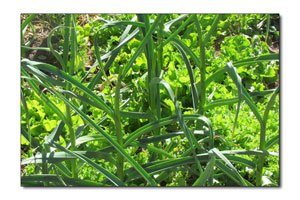|
|
Eat your green mulchby Ari LeVaux Meteorologists are scrambling to find anything comparable to weather that has been dubbed Summer in March. Two days before the official end of winter, temperatures of 94 were recorded in South Dakota. If we’re having summer in March, what can we expect in July? Even in a normal summer, the process of mulching should be on every gardener’s mind as we say “good morning” to our gardens. But this year, the idea of heat-proofing the garden is especially timely. Mulching – aka covering the soil – helps regulate soil temperature and moisture while keeping the soil from blowing away in the wind. In addition to deflecting sun and wind, mulching can also block weed growth and prevent runoff from heavy rains, which many regions can expect more of in a warming climate. Straw, leaves, grass clippings, pulled weeds, compost and other organic materials are typically used for mulch, as are living plants such as vetch between cornrows, or clover in the orchard. Such living mulch, aka green mulch, can do everything a layer of straw can, and oftentimes more. Most green mulches are legumes that add nitrogen to the soil as they protect and stabilize it. But edible living mulches can be employed as well, with obvious benefits. I began experimenting with a proprietary technique I call “hurling random vegetable seeds at the garlic patch.” I mixed together all the leftover seeds from previous gardens that I had saved in various baggies and crumpled envelopes. I threw handfuls of mixed seeds into the garlic to see what grew, how well it did, and if it adversely affected the garlic. Bushy plants like tomatoes began swallowing garlic plants in late June, and had to be pulled before they could produce. Plants in the mustard family, like broccoli and kale, grew poorly, perhaps victims of garlic’s well-known allelopathic behavior. Allelopathy is the ability of some plants to secrete substances into the soil, via the roots, which inhibit the growth of neighboring plants. Eventually two categories emerged as edible green mulches for the garlic patch. One category, the early-season greens, includes lettuce, radicchio, escarole, endive, spinach and other leafy greens outside of the mustard family. During the early stages of the season, when the young garlic plants are just a few inches tall, these greens basically have the whole garlic patch to themselves. As soon as the leaves reach edible size, I start harvesting them – just the leaves, not the whole plants. The other category is carrots, planted at the same time as the greens. During the early season, the fast-growing greens tend to crowd and shade the carrots (though not the garlic, which is usually about 6 inches taller). By June, most of the leafy plants will have run their course and gone to seed. As the greens fade, the carrots begin to take over between the garlic plants. Carrot and garlic will grow side by side, rarely getting in each other’s way. Underground, carrot and garlic don’t butt roots, while above ground the bushy carrot tops guard the soil surface. Once the garlic is harvested, in July, the carrots have the whole patch to themselves, and can stretch out comfortably into their expanded space. By the time the carrots are dug, I’ll have harvested three different crops in one season from the same piece of dirt: garlic, greens and carrots. The living mulch will have done a service for my topsoil by protecting it from the elements. This kind of diversity-focused gardening falls into the broad category of agroecology, the practice of building diverse, sustainable agriculture systems based on ecological principles. While dismissed as nonscientific woo-woo by many who favor industrial-style farming, the discipline of agroecology is currently being taught at about 20 universities worldwide, including UC-Santa Cruz, Iowa State and Penn State. Given that this year is shaping up to be a hot one, with more likely to follow, now is a great time for this kind of mulchy thinking. Whatever you grow, and whatever you mulch with – living or dead – the game is essentially the same: cover as much ground as possible. If an edible mulch can do the job, all the better. |
In this week's issue...
- January 25, 2024
- Bagging it
State plastic bag ban is in full effect, but enforcement varies
- January 26, 2024
- Paper chase
The Sneer is back – and no we’re not talking about Billy Idol’s comeback tour.
- January 11, 2024
- High and dry
New state climate report projects continued warming, declining streamflows


